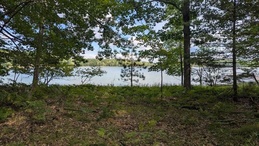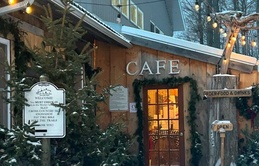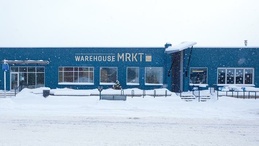Sun, Wind and Power
April 19, 2009
Sun, Wind and PowerA new take on living large
By Anne Stanton
Lots of people would prefer to “do the right thing” as far as building an energy-saving home, but the cost and complexity are daunting for most folks.
Gary Woodcock has a vision that would change that reality, and has formed a new company called Healthy Green Homes. He aims to build “green” homes and to remodel existing homes at a price or size that people can afford.
But first, he has to finish building a model home on his 10 windy acres outside of Maple City. The home will have 1,000 square feet, but the 24-foot ceiling and loft will give it a spacious feeling. Its electrical source will come from the sun and wind.
“We won’t have to listen to a generator, or buy electricity or gasoline or smell the fumes or pollute the earth, Woodcock said.
The trade-off? The size of their home is smaller than most traditional homes.
“I’ve been asked why do we want to buy such a little house,” Sandy said. “Now people are saying, we think you’re really smart.”
A licensed builder, Woodcock spent most of his career building and remodeling traditional homes. Yet he’s long believed the future lies in smaller homes that are good for the earth and human health.
“Darwin had a saying that it’s not the strongest species that survives, but the species that’s most adaptable,” he said.
Woodcock, who cuts a slim figure, has learned how to adapt a home to take advantage of alternative energy.
“We’ve learned a lot. This has been an incredible learning experience. When you start off on something like this, you don’t know how much you don’t know.”
PEAK OIL
Woodcock and his wife Sandy said their first wake-up call came from a Peak Oil and Solutions conference in Yellow Springs, Ohio, several years ago.
“We’d been concerned about what’s going to happen when the energy costs go through the ceiling. We wondered, how could we live, or begin to live, and this conference pointed us in a direction in which there wouldn’t have to be chaos, a direction in which we could re-orient ourselves to live more simply and more meaningfully,” Woodcock said.
“We learned there are a lot of people out there concerned and doing something about it. And so this seemed like a perfect fit. Yes, we can have this modest home that may not cost us anything in terms of energy. It can be an example of what’s possible.”
For information and inspiration, the Woodcocks talked to their like-minded friends, and subscribed to several magazines, including Home Power, Solar Today, Yes and Ode.
His biggest inspiration came from an alternative energy community in Asheville, North Carolina, called Westwood, where there are 25 units on four and a half acres.
“There are solar collectors on the roof of the community building, which heats the water that’s distributed to all the people’s homes for both their heat and domestic hot water. I saw solar technology actually applied and working without any problems at all for nearly 13 years, and Westwood now has a waiting list of 50 people. It was the most hands-on, real life example, and this was basically old technology, and it wasn’t even utilizing the newest stuff.”
Westwood is also about living as a community. The residents make decisions together and occasionally share a meal. “It was compact and it just worked,” he said.
NEW DIRECTION
After that visit, Gary—with Sandy’s help—began building a home that wouldn’t depend on the traditional electric grid. Nonetheless, it will be hooked up to the grid so they can sell the excess energy back to the electric company—a possibility thanks to a net metering law that’s expected to pass the Michigan Legislature this year.
The couple also applauded President Barack Obama’s extension of a soon-to-expire 30 percent federal tax credit for photo voltaic panels and solar thermal collectors. He also removed the $2,000 cap and made wind turbines eligible for the tax credit.
“All of this really opens things up in a big way,” Gary said. “For the last several years, there’s been no incentive program for small wind energy and now the phones are ringing off the hook.”
Woodcock believes that government investment in alternative energy will give a big pay-off in terms of jobs: Germany employs 370,000 people in the alternative energy arena; Sweden has 400,000 jobs in the field. To get things moving in the green direction, Woodcock is getting involved with the Michigan Homebuilder’s Association.
“Michigan is perfectly poised to create an industry. We have the manufacturing capacity and the coastline to ship the product to anywhere in the world.”
TRADE-OFFS
Part of the critique over alternative energy is that it sometimes takes more fossil fuel to manufacture and transport energy-saving products than the actual energy saved.
That’s a very important concern, Woodcock said, and technology is swiftly changing to lower what’s called the “embodied energy.”
“The photovoltaic panels we’ll use on our home is made by Uni-Solar, a company in Greenville, Michigan. And this particular product is designed for overcast climates like ours,” he said. “Eighty percent of what they manufacture goes to Germany, a country that’s even cloudier than us.”
The photovoltaic panel has one-tenth of the embodied energy of the 1970s version. But Gary said that even if the technology isn’t perfect now, there’s no time to wait.
“Will Rogers once said, even if you’re on the right track, you’ll get run over if you just sit there,” he said.
The photovoltaic panels absorb portions of the ultraviolet spectrum that comes through the clouds and can give you a sunburn. Those ultraviolet rays are converted to electricity and stored in batteries for electrical use whenever it’s needed.
Woodcock is even using solar energy to build the house. His lights, radio, table saws, compressors—everything –is powered solely by two photovoltaic panels, which collect energy that flow to deep cycle, rechargeable batteries, which are connected to a borrowed inverter that channels the electricity to 110-volt outlet.
ENERGY FEATURES
Here’s some of the technology employed in the construction:
• A small wind turbine will produce up to 1,000 watts per hour.
Solar voltaic panels on the south-facing roof will generate more than 1,000 watts per hour.
• The home is super insulated, and employs what’s called a frost-protected shallow foundation, which is used extensively in Scandinavia, but very little in the United States. It uses eight inches of high-compression foam underneath the concrete slab to avoid losing heat to the Earth. It also has tubing that loops through the concrete. Heated water will run through the tubing to heat the floor and home.
• The windows are one of the most relatively expensive “green” components and come from Canada. They are thick—nearly one and a half inches—and triple paned. They are so heavy they must be supported by fiberglass frames. They take in more energy into the home than leaves them.
• Glass vacuum tubes on a ground-mounted rack contain a refrigerant that boils and turns into a vapor of up to 300 degrees. The vapor gives off its heat to water lines that go into the house; the hot water is stored in tanks for future use.
• Wood used in the home is either recycled or purchased new in Michigan.
• There is no PVC, which is important because of the toxic elements released when the PVC is discarded, manufactured and installed. “If you’ve smelled PVC glue it’s the noxious, nasty stuff. Some people get very, very sick from it,” Woodcock said.
DOWNSIZING
The Woodcocks have lived all over the country with their two children (now adults) and over the years gradually downsized their homes. And that’s key. If you’re willing to live in an 800-square-foot home, you could build an alternative energy home for about $150,000 (excluding property), which is affordable for most middle-class families, Woodcock said.
The Woodcocks are toying with the idea of building a development modeled after the one in Asheville, North Carolina.
Although Maple City is a good hike from Traverse City, there’s a food co-op in the area and a nearby bus stop. Plus, their property is 10 minutes away from the Sleeping Bear Dunes National Lakeshore, with some of the most beautiful coastline in the world. The couple thinks there are enough like-minded people to make a go of it.
“If people want to get the maximum square footage for the least amount of cost, this isn’t a house for them,” Woodcock said. “If they have concern of their impact on the earth, a healthier environment for their children and grandchildren, want to spend less money on utilities and property taxes, and want an affordable home far into the future, this would be something to seriously consider.
“… I’m more optimistic about the future than in the 1960s when we went to the moon. It’s the most exciting time to be alive right now. I’m inspired about the possibilities.”
To contact Gary Woodcock, call him at 590-7424 or 228-6150.
Trending

Welcoming the Winter Solstice: Rituals & Events for the Shortest Day of the Year
With the winter solstice quickly approaching, it’s hard not to notice how dark each day feels. Astronomically, this is… Read More >>
Camp Greilick Now Open!
It’s been a long road for the century-old Camp Greilick, which, after several dormant years, was acquired by Grand Tra… Read More >>
Men and Ugly Sweaters
Those two things don’t always go together, but on Dec. 19, you’ll see both out and about in Petoskey and Harbor … Read More >>


